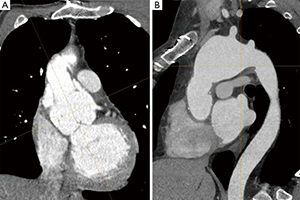Re-interventions on the thoracic and thoracoabdominal aorta in patients with Marfan syndrome
Abstract
The advent of multi-gene panel genetic testing and the discovery of new syndromic and non-syndromic forms of connective tissue disorders have established thoracic aortic aneurysms as a genetically mediated disease. Surgical results in patients with Marfan syndrome (MFS) provide an important benchmark for this patient population. Prophylactic aortic root surgery prevents acute dissection and has contributed to the improved survival of MFS patients. In the majority of patients, re-interventions are driven by a history of dissection. Patients undergoing elective root repair have a low risk for re-interventions on the root itself. Experienced centers have results after valve-sparing procedures at 10 years comparable with those seen after a modified Bentall procedure. In patients where only the ascending aorta was replaced during the initial surgery, re-intervention rates are high as the root continues to dilate. The fate of the aortic arch in MFS patients presenting with dissection is strongly correlated with the extent of the initial surgery. Not replacing the entire ascending aorta and proximal aortic arch results in a high rate of re-interventions. Nevertheless, the additional burden of replacing the entire aortic arch during emergent proximal repair is not very well defined and makes comparisons with patients undergoing elective arch replacement difficult. Interestingly, replacing the entire aortic arch during initial surgery for acute dissection does not protect from re-interventions on downstream aortic segments. MFS patients suffering from type B dissection have a high risk for re-interventions ultimately leading up to replacement of the entire thoracoabdominal aorta even if the dissection was deemed uncomplicated by conventional criteria. While current guidelines do not recommend the implantation of stent grafts in MFS patients, implantation of a frozen-elephant-trunk to create a stable proximal landing zone for future endovascular or open procedures has emerged as a means to address aortic arch and descending aortic pathologies.
Cover






